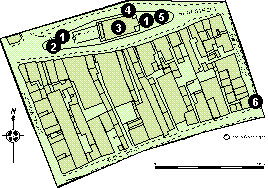 Elgin: Area 6
Elgin: Area 6This page was copied from: http://www.suat.demon.co.uk/elgin_bs/elgin_a6.htm for informational and historical purposes. Please note original copyright at bottom of page. Duffuses had an early presence in Elgin.
 Elgin: Area 6
Elgin: Area 6

Defined by High Street to the north, South Street to the south, Batchen Street to the west and Commerce Street to the east. It contains St Giles church, the site of the Tolbooth and the former market place.
Click here for a full size map (25K)
Archaeological excavations in 1995 in response to environmental improvements located the wall foundations of the 18th century tolbooth at c 0.3 m below modern ground level close to the Plainstones fountain. Monitoring of service trenches and tree pits on both sides of St Giles church located 23 articulated skeletons buried in graves at c 0.50m below modern ground level (pers comm J.Lewis).
This stood to the west of the church approximately where the fountain now stands. The early version of this building (16th century) was probably built of timber and thatch. By 1602, it had become ruinous and was replaced in stone, surviving until 1702 when it was damaged by fire. The site was totally cleared in 1843 (Simpson and Stevenson 1982, 8). Recent excavation has located the foundations of this structure (see no 1).
The discovery of a Pictish symbol stone within the confines of the kirkyard in 1823 (see 3 below) raises questions over the antiquity of the site. There has been a church in this position since at least the late 12th century. The early building was burned by the Wolf of Badenoch 1390, and the restored building survived raids in 1402 and 1452. The roof collapsed in 1679 and was rebuilt. Further work in the 18th century removed the transepts to allow for street widening, and the chancel was demolished in 1801.
At the beginning of 19th century only the nave and tower of the old church remained, and these were removed to build the current church in 1826. The graveyard was closed in the same year. This graveyard seems to have served a dual function, as both burial ground and market place. There are references to the site still being maintained in the late 16th / early 17th centuries as Kirk Session records refer to repairs to the kirkyard dyke between 1596 and 1625. Burial in the graveyard ceased about the first half of the 17th century (Simpson and Stevenson, 1982, 26).
Human remains were discovered in 1984 in a service trench on the S exterior of the building and beneath the floorboards in the centre of the church (Shepherd 1984, 12).
This was discovered in 1823 during repairs to the High Street within the former churchyard of St Giles. The stone, known as the Elgin Pillar, lay horizontally 0.6 m below the ground surface to the north east of the old church. It was inscribed with Pictish symbols and a cross with interlace decoration (Simpson and Stevenson 1982, 17).
This is the original market cross erected in the reign of Charles I. It was demolished in 1792 and then restored in 1888. The market site was very cramped on the east side of the church, and in 1786 the area to the west of the church was laid out as a market place known as the `Plainstones' (Simpson and Stevenson 1982, 5).
This formerly stood at the head of Commerce Street. In 1745 it was described as being `in danger of falling' and was finally demolished in 1795 because it was obstructing traffic (Simpson and Stevenson 1982, 19).
This central area is very important; recent excavation (see no 1), and the discovery of a Pictish symbol stone under the High Street at a depth of 0.6 m, suggest that deposit preservation may be good. The discovery of the symbol stone may have important implications for the origins of any early church in this area. The potential of this area is very high particularly with regard to pre-burghal origins, and any development proposals should take the archaeological implications into account. Any work on the closes that run back from the High Street may repay careful monitoring.
Copyright © Scottish Urban
Archaeological Trust Limited
55 South Methven Street, PERTH, PH1 5NX
Tel: +44 (0)1738 622393
Fax: +44 (0)1738 631626
E-Mail: [email protected]